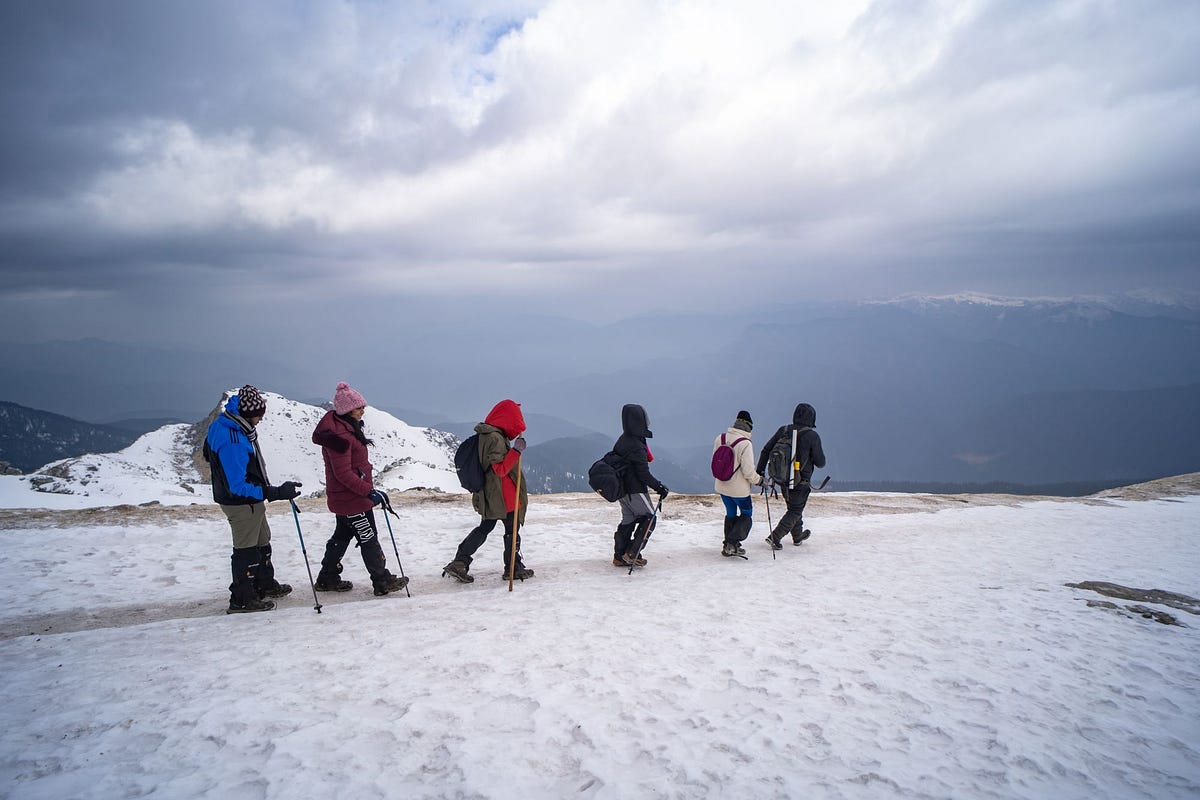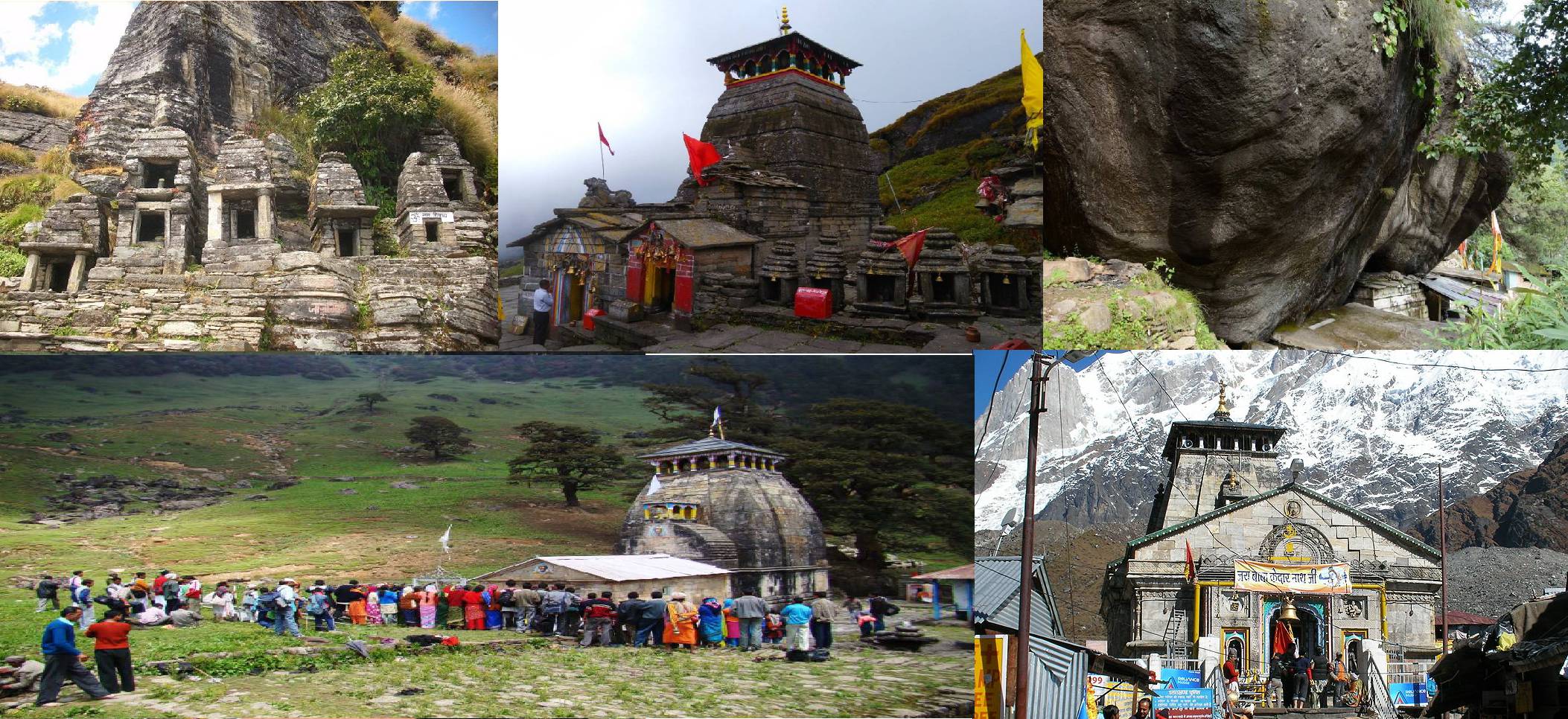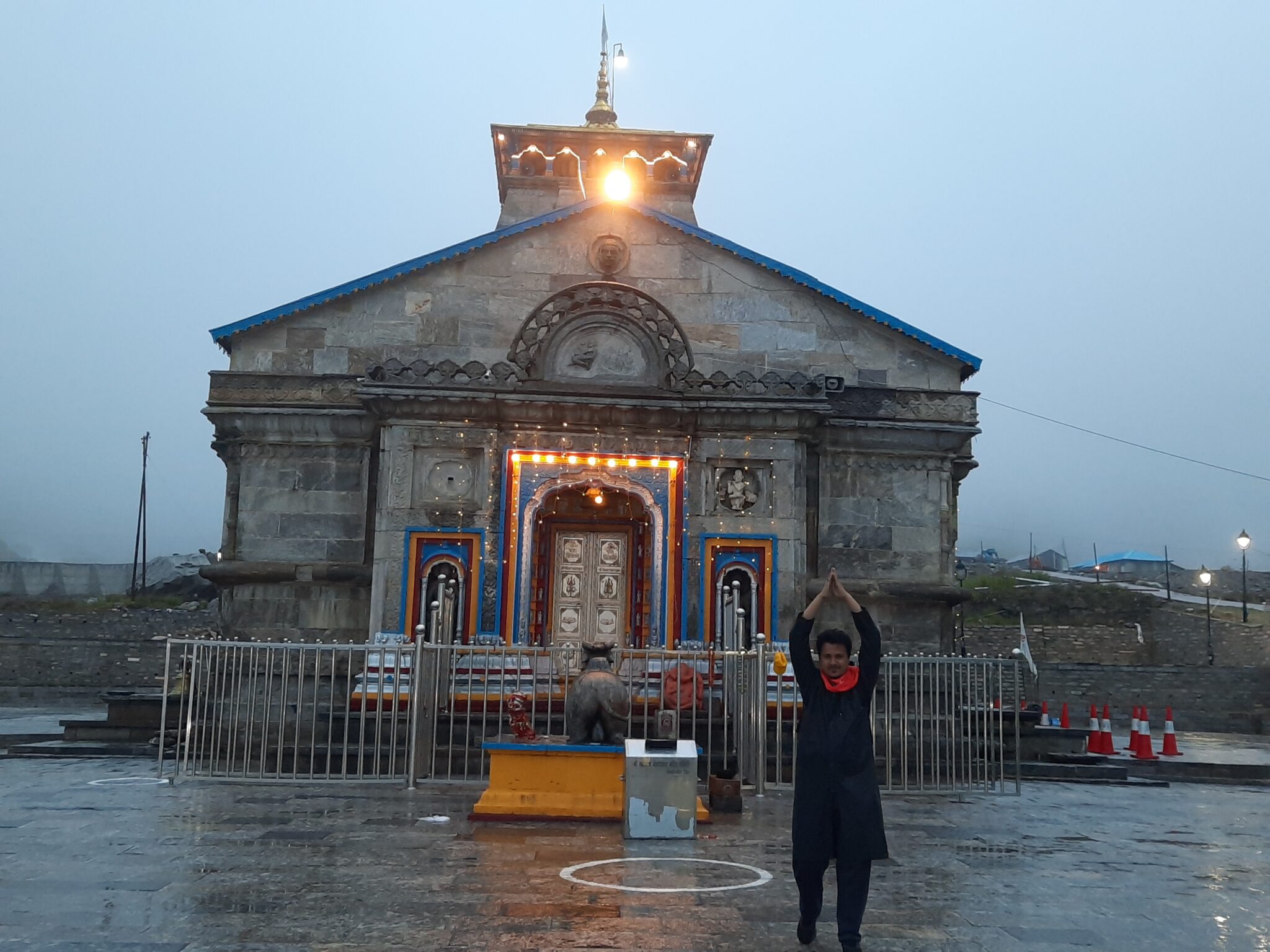- 05 NIGHTS / 06 DAYS




The Complete Guide To Panch Kedar Trek
Scattered across Uttarakhand are numerous temples venerating various deities from the Hindu pantheon. In the Garhwal region of the state, five esteemed shrines are dedicated to the worship of Lord Shiva, collectively known as Panch Kedar, with Kedarnath, Madhmaheshwar, Tungnath, Rudranath, and Kalpnath. The formation of these sites has diverse mythological explanations. According to a prevalent narrative, during a bygone age chronicled in Hindu scriptures, the Pandava princes, protagonists of the Mahabharata, were advised to seek penance in Uttarakhand to atone for the bloodshed in the war. Legend has it that Lord Shiva, concealing himself in the form of a buffalo, was uncovered by Bhima, one of the Pandava brothers. Upon recognition, the deity vanished and materialized in five distinct Himalayan locations. Each of these sites is believed to represent a specific aspect of the Lord: Kedarnath symbolizes the hump, Madhmaheshwar represents the belly button, Tungnath embodies the arms, Rudranath depicts the face, and Kalpeshwar signifies the jata or hair.
Short Itinerary
Highlights of the Trek -
Travel to all the five Panch Kedar temples in a single journey.
Trek inside deep forests and reach summits with outset mountain views.
Availability of dhabas and stay options allows you to pace your trek according to your fitness level and the amount of time you have.
Detailed Trail Information
Day 1: Haridwar to Helang
Altitude: 6,696 ft
Time taken: 9 hours drive from Haridwar
If you are traveling by train, reach Haridwar or Dehradun early in the morning or the previous night. Shared taxis are available from outside either of the railway stations early in the morning. These charge Rs.600-800 per seat.
Another option is to take an overnight bus from Dehradun to Joshimath. Helang is before Joshimath on this route - ask your bus driver to halt here.
Day 2: Helang to Kalpeshwar via Lyari. Return to Helang and drive to Saggar
Altitude: 7,217 ft
Time taken: 5-6 hours trek including the walk to Lyari if the road is broken.
Trek gradient: Easy - moderate. Mostly flat trail to villages and fields
Water sources: You will get one water source on the trail to refill your water bottles.
The total trek distance from Lyari to Kalpeshwar is 4.5 km. Most of the trek consists of a flat walk and is not very difficult.
Set out early from Helang. This way, you can return and proceed to Saggar, which is a 2 hours drive from Helang.
The idyllic trek is through quaint villages of the Urgam valley. You walk past fields initially and then through lush meadows. You can see the Kalpganga river to your right.
The bridge on the across the river just before the temple was washed away during the cloudburst and floods of 2013. A balanced walk over the makeshift bridge and the final climb takes one to the rustic temple of Kalpeshwar. A 150 meters side trip from the main road near Lyari, takes one to Dhyan Badri temple. It is not part of the Panch Badri temples, but it is worth visiting this ancient temple.
The next stop on this trek is Rudranath. There are three options to do this part of the trek. One is to continue from Devgram via Kalgot. You will find more details here. The other option is to drive from Helang to Saggar and begin the the trek from there. The details mentioned here are for going to Rudranath from Saggar via Panar and descending via Nala Pass and Anusuya Devi temple. You can also reverse this route. However, keep in mind that the Panar route has a lot of steps on a steep trail, which can make descending on this route tough on your knees.
Day 3: Saggar to Panar
Altitude: 11,155 ft
Time taken: 6-8 hours; 12 km
Trek gradient: Difficult. Steep climb all the way to Panar
Water sources: You can refill your water bottles from streams or at dhabas on the trail.
Take the route through Saggar. This is where Suryavanshi King Saggar, a descendant of King Harishchandra, had spent his childhood.
The route is a very steep climb through a dense forest. The trail is well laid, with steps cut out all the way to Panar.
On the way you hear the chirping of birds, noise of the crickets and cicadas, rustling of leaves by the langurs. The gurgling waterfalls add to the surreal experience. Drinking water directly from the freshwater streams is rejuvenating. There are hardly any trekkers to be seen.
There are less than half a dozen dhabas on the entire route to Rudranath. These dhabas provide good food and basic overnight staying facilities. One positive aspect of these dhabas was the availability of enclosed toilets.
From Panar you can see the beautiful snow-capped mountains of Nanda Devi, Trishul and Nanda ghunti and the Bandarpoonch massif. In the month of August and September Panar turns into a carpet of pinkish red flowers. There is a dhaba in a smaller meadow just before Panar (Lungti Bugyal), where you can stay overnight.
Day 4: Panar to Rudranath. Return to Panch Ganga
Altitude: 11,811 ft
Time taken: 6-7 hours; 11 km
Trek gradient: Moderate-Difficult. Steep climb all the way to Panar
Water sources: None till you reach Panch Ganga. Carry at least 2 litres of water.
Start early in the morning for Rudranath. Take the trail that moves towards the ridge to the left. You will see some huge boulders and snow capped peaks to your left.
The trail gradually climbs up the ridge. You will notice some undergrowth on the way. After 25-30 minutes of ascent, you can see the Panar meadows below. In another 30-40 minutes, you reach a huge overhanging boulder on the left. From here, the scene is magnificent – the vast green meadows of Panar below and snow capped peaks in front, engulfed in clouds.
Continue on the trail that climbs up the ridge. As you climb up you see huge boulders on the right and in the front. You will pass several boulders and eventually reach the ridge between Panar and Rudranath. The views of the Himalayas from this ridge are unmatched. You are surrounded on all sides by snow capped peaks and lush green valleys.
This is also the place where you see another trail going down to the left. This is the one to Anusuya Devi, which you will take on the return.
Proceed ahead on the trail. You are now surrounded by colourful flowers and shrubs. Notice the temporary shepherd settlement made of stone to your left. Continue on the mud trail that gradually ascends, keeping the valley to your left. You will soon see prayer bells and flags in the distance. It takes 15-20 minutes to reach them.
This is Panch Ganga, the highest point on this trail. It takes 3-3.5 hours to reach here from Panar. Enroute, you also pass Pitradhar, where our forefathers are said to have departed for the other realms. There is a small unattended shrine here. The view from Rudranath temple is stupendous. We see a wide range of icy Himalayan mountain peaks. Nanda Devi and Kamet peaks look very enticing, specially at sunrise.
From Panch Ganga, the trail now descends into the valley. You see bright flowers and shrubs around. This valley is known for medicinal herbs. Continue on the trail as it climbs up a ridge. Spread over a couple of hundred metres on either side of the ridge are colourful wildflowers and a lush green meadow.
Rudranath shrine becomes visible at a distance after an hour of hike. The trail descends first and then ascends. In 25-30 minutes you will reach a brightly painted tourist hut. It has 2 rooms that are used by pilgrims and tourists who wish to stay overnight at Rudranath. You can also make your way to back to Panch Ganga and stay at a dhaba there.
Day 5: Panch Ganga to Mandal via Naola Pass and Anusuya Devi temple
Altitude: 14,000 ft
Time taken: 7-8 hours; 11 km
Trek gradient: Moderate. Steep descent to Anusuya Devi followed by a moderate descent to Mandal
Water sources: One dhaba just before Anusuya Devi temple. Carry at least 2 litres of water.
The route via Naola Pass is through an isolated forest, offering splendid views at every clearing. It is a unique sight to see mountain goats on precarious slopes. If lucky, you might even sight a viper snake. There is only one dhaba on the way to Anusuya Devi. It is likely that you will not meet even a single pilgrim enroute!
There is a possibility that you might have to cross a tributary of the Ganga on the way by wading through it if the bridge over it is broken. If you are attempting this route in monsoon, check at Panch Ganga before proceeding whether it is safe to cross the river.
Anusuya Devi is 11 km from Panch Ganga. It will take you 3-4 hours to get here.
Story of Anusuya Devi: The three Goddesses Lakshmi, Saraswati and Parvati were very vain about their prowess. Devrishi Narad informed them that there is a lady called Anusuya who is more superior. She was the wife of Brahmarishi Atri. The 3 jealous Goddesses coaxed their respective husbands to go and test her. Lords Brahma, Vishnu and Shiva hesitatingly approached her. They decided to ask her a tough question which would be impossible for her to fulfill and then they would be able to quickly return. They posed as Brahmins and asked her for food. But the condition was that she had to serve them in a naked form. Anusuya was shocked but realized that the Brahmins must be fed. She thought of her husband Atri for help, who was meditating in a nearby cave. She then sprinkled water on the 3 Brahmins, who turned into newborn infants! The 3 Lords were humbled. They blessed Anusuya with 3 kids viz. Dattatreya, Soma and Durvasa, who are their incarnations. They also blessed her that couples who have difficulty in becoming parents can approach her.
There is an optional detour to Atri Rishi’s cave once you cross the stream. Proceed to Mandal after seeing Anusya Devi temple. The bus to Chopta is at 1.00 pm the following day.
Day 6: Reach Chopta
Chopta is about an hour's drive from Mandal. This is a very beautiful drive. The only bus leaves at 1.00 pm. Get some well deserved rest in the morning before boarding the bus.
Chopta is the base for a small but uphill trek to Tungnath temple. Tungnath is the highest located Shiva temple in the world.
Day 7: See Tungnath. Reach Ransi
Altitude: 12,083 ft
Time taken: 2-3 hours; 6 km
Trek gradient: Moderate. Steep ascent to Tungnath
Water sources: None. Carry at least 2 litres of water.
The trek from Chopta to Tungnath is accessible via a cemented pilgrim trail. The trail ascends sharply via a series of 11 scissor bends. The walk is pleasant, but is a very steep climb. The trek up to Tungnath temple is approximately 3 km. After you reach the 10th scissor bend, look for a flag and a small open temple towards your right side.
You can now see Chandrashila peak and Tungnath temple complex at the base of the peak. The views from here onwards are incredible. A connecting peak leading to Chandrashila, known as Ravanshila, is visible to your right.
Tungnath temple is only half a kilometre away from here. Towards your left, overlooking the valley is a section of Birch trees (Bhojpatra). This is a haven for birds like Monal and Griffin vulture. Take the 11th and last bend to reach the famous and holy Tungnath temple.
The temple is closed in winter and you will find snow here from late December until around April.
Return to Chopta on the same trail. Board the afternoon bus to Ukhimath. Take the connecting bus from Ukhimath and reach Ransi by evening. The connecting bus waits for the bus from Chopta before starting from Ukhimath.
Ukhikmath is well known for the famous Omkareshwar temple, home to the idols from Kedarnath and Madhyamaheshwar in winter.
Day 8: Trek to Nanu, enroute Madhyamaheswar
Altitude: 7,743 ft
Time taken: 6 hours; 10 km
Trek gradient: Moderate.
Water sources: Carry two litres of water and keep hydrating yourself. You can refill your water bottles from dhabas along the trail.
Ransi is the starting point for another arduous trek to Madhyamaheshwar. The trail is well marked and easy to follow. The flora on the route is amazing and so is the fauna. You will see butterflies, mountain goats, lizards, sheep, guard dogs, monkeys, several birds etc. The village kids seem to be living their lives to the fullest.
The temple itself is set against a very beautiful backdrop of sloping hills and meadows. Another small trek to Budha Maheshwar is recommended for those who want to see a nice sunrise.
The trail from Ransi begins with a gentle ascent for about 25 minutes and tapers off into a level walk. Another 10 minutes into it, you will see the trail passing through a small stream near a stone made hut which is a part of the “Gharat” system used to grind wheat using the ancient water wheel technology. Continue on the mud path for 10-15 minutes and you will see that the trail now enters a green forest with huge trees on both sides. The trail now moves downwards on a stone paved path.
Continue descending on the stone paved trail for 45 minutes to an hour till you reach the bridge over a river, with a grand view and deafening roar of a waterfall cascading down. Cross the river coming from your left on a steel bridge and you are on the trail, which now starts to climb up gently. Continue on the trail for 20 minutes until you see a huge boulder on your left. The overhanging boulder with walls built on 2 sides serve as a temporary rest area. Continue the upward climb for 1 km and you will reach Gaundhar, a scenic place. On the way you cross 2 more bridges at an interval of 5-10 minutes each. Also you come across a small temple on the right hand side of the trail. It takes around 2 hours to reach Gaundhar from Ransi. You can break here for lunch.
After having lunch continue on the trail that descends down. You can see the steel bridge after descending down for 10-15 minutes. After crossing the bridge you come to Bantoli village. This is 1 km from Gaundhar. Bantoli is a fantastic place, ideally facing the confluence of MartyendaGanga and Madhymaheshwar ganga. You will see a few houses with straw on roof with a lot of welcome sentences written in Bengali. Continue on the trail and you will come across the two storied Vishwa Lodge.
The trail now ascends in the north-west direction from Bantoli towards Nanu. Continue ascending on the trail for 15- 20 minutes and you will see the top view of thick forested growth, with two rivers Madhymaheshwar Ganga and Martyenda Ganga and a bridge on one of the rivers. The trail which we traversed an hour ago is also in focus. Another 45 minutes into the trail and you will come across a huge boulder on the left side of the trail.
Continue on the trail till you reach Khatara which consists of just two shacks, one a dhaba and a shelter for pilgrims with very basic amenities. Khatara is 2 km from Bantoli. The trail continues uphill gradually on the stone paved path. Continue on the trail for another 30 minutes and you will see the trail is now covered with a pile of brown leaves shed by trees on both sides of the trail. Slight drizzle to heavy rain is a common phenomenon in June. Continue on the trail that goes uphill for another 1 – 1.5 hours and you will reach Nanu. You can camp here tonight or stay in the lodge.
If you are running short of time, you can also consider trekking all the way to Madhyamaheshwar, which is 6 km ahead of Nanu.
Please contact us for more detailed content using the number +91 9811014398 / 9811925848
The Complete Guide To Panch Kedar Trek
Scattered across Uttarakhand are numerous temples venerating various deities from the Hindu pantheon. In the Garhwal region of the state, five esteemed shrines are dedicated to the worship of Lord Shiva, collectively known as Panch Kedar, with Kedarnath, Madhmaheshwar, Tungnath, Rudranath, and Kalpnath. The formation of these sites has diverse mythological explanations. According to a prevalent narrative, during a bygone age chronicled in Hindu scriptures, the Pandava princes, protagonists of the Mahabharata, were advised to seek penance in Uttarakhand to atone for the bloodshed in the war.
Situated on the Rudraprayag - Kedarnath road, Gaurikund (1981 m.) provides a breathtaking view of the Himalayan ranges.
The trek goes through alpine meadows and huge dense forests with a panoramic view over the Nanda Devi, Trishul and Nanda Ghunti peaks.